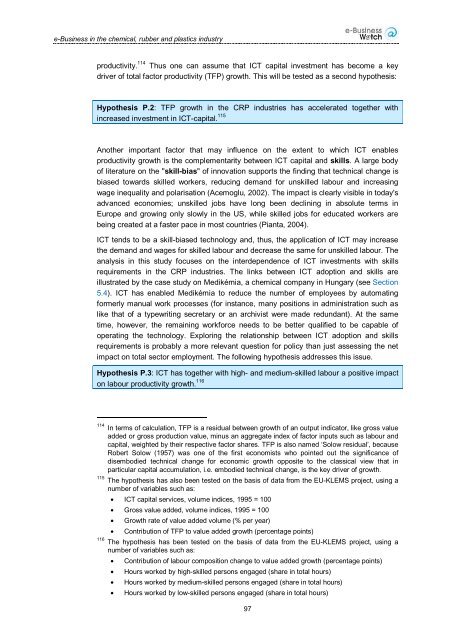Downloads - empirica
Downloads - empirica
Downloads - empirica
Create successful ePaper yourself
Turn your PDF publications into a flip-book with our unique Google optimized e-Paper software.
e-Business in the chemical, rubber and plastics industryproductivity. 114 Thus one can assume that ICT capital investment has become a keydriver of total factor productivity (TFP) growth. This will be tested as a second hypothesis:Hypothesis P.2: TFP growth in the CRP industries has accelerated together withincreased investment in ICT-capital. 115Another important factor that may influence on the extent to which ICT enablesproductivity growth is the complementarity between ICT capital and skills. A large bodyof literature on the "skill-bias" of innovation supports the finding that technical change isbiased towards skilled workers, reducing demand for unskilled labour and increasingwage inequality and polarisation (Acemoglu, 2002). The impact is clearly visible in today'sadvanced economies; unskilled jobs have long been declining in absolute terms inEurope and growing only slowly in the US, while skilled jobs for educated workers arebeing created at a faster pace in most countries (Pianta, 2004).ICT tends to be a skill-biased technology and, thus, the application of ICT may increasethe demand and wages for skilled labour and decrease the same for unskilled labour. Theanalysis in this study focuses on the interdependence of ICT investments with skillsrequirements in the CRP industries. The links between ICT adoption and skills areillustrated by the case study on Medikémia, a chemical company in Hungary (see Section5.4). ICT has enabled Medikémia to reduce the number of employees by automatingformerly manual work processes (for instance, many positions in administration such aslike that of a typewriting secretary or an archivist were made redundant). At the sametime, however, the remaining workforce needs to be better qualified to be capable ofoperating the technology. Exploring the relationship between ICT adoption and skillsrequirements is probably a more relevant question for policy than just assessing the netimpact on total sector employment. The following hypothesis addresses this issue.Hypothesis P.3: ICT has together with high- and medium-skilled labour a positive impacton labour productivity growth. 116114 In terms of calculation, TFP is a residual between growth of an output indicator, like gross valueadded or gross production value, minus an aggregate index of factor inputs such as labour andcapital, weighted by their respective factor shares. TFP is also named ‘Solow residual’, becauseRobert Solow (1957) was one of the first economists who pointed out the significance ofdisembodied technical change for economic growth opposite to the classical view that inparticular capital accumulation, i.e. embodied technical change, is the key driver of growth.115 The hypothesis has also been tested on the basis of data from the EU-KLEMS project, using anumber of variables such as:• ICT capital services, volume indices, 1995 = 100• Gross value added, volume indices, 1995 = 100• Growth rate of value added volume (% per year)• Contribution of TFP to value added growth (percentage points)116 The hypothesis has been tested on the basis of data from the EU-KLEMS project, using anumber of variables such as:• Contribution of labour composition change to value added growth (percentage points)• Hours worked by high-skilled persons engaged (share in total hours)• Hours worked by medium-skilled persons engaged (share in total hours)• Hours worked by low-skilled persons engaged (share in total hours)97
















